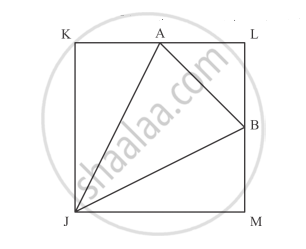Advertisements
Advertisements
प्रश्न
A piggy bank contains hundred 50 p coins, seventy ₹1 coin, fifty ₹2 coins and thirty ₹5 coins. If it is equally likely that one of the coins will fall out when the bank is turned upside down, what is the probability that the coin will not be a ₹5 coin?
उत्तर
Number of 50 p coins = 100.
Number of ₹1 coins = 70.
Number of ₹2 coins = 50.
Number of ₹5 coins = 30.
Thus, total number of outcomes = 250.
Let E2 be the event of not getting a ₹5 coin.
Number of favourable outcomes = 250 − 30 = 220
∴ P(not getting a ₹5 coin) = P(E2) = `("Number of outcomes favourable to" E_2)/"Number of all possible outcomes"`
`= 220/250 = 22/25`
Thus, the probability that the coin will not be a ₹5 coin is `22/25`.
APPEARS IN
संबंधित प्रश्न
Two dice are thrown. Find the probability of getting :
1) The sum of the numbers on their upper faces is at least 9.
2) The sum of the numbers on their upper faces is 15.
3) The number on the upper face of the second die is greater than the number on the upper face of the first die.
In the Fig. below, JKLM is a square with sides of length 6 units. Points A and B are the
mid- points of sides KL and LM respectively. If a point is selected at random from the
interior of the square. What is the probability that the point will be chosen from the interior of ΔJAB?

A bag contains 18 balls out of which x balls are red.
(i) If one ball is drawn at random from the bag, what is the probability that it is not red?
(ii) If 2 more red balls are put in the bag, the probability of drawing a red ball will be `9/8` times the probability of drawing a red ball in the first case. Find the value of x.
A balloon vendor has 2 red, 3 blue and 4 green balloons. He wants to choose one of them at random to give it to Pranali. What is the probability of the event that Pranali gets, a red balloon
A card is drawn at random from a well shuffled pack of 52 playing cards.
Find the probability that the card drawn is a spade.
Solve any two of the following.
If two coins are tossed simultaneously, find the probability of getting a head on both the coins.
A box contains 20 cards numbered from 1 to 20. A card is drawn at random from the box. Find the probability that the number on the drawn card is divisible by 2 or 3
A black die and a white die are thrown at the same time. Write all the possible outcomes. What is the probability? that the product of numbers appearing on the top of the dice is less than 9.
A bag contains 5 red, 8 green and 7 white balls, One ball is drawn at random from the bag. What is the probability of getting a white ball or a green ball?
If \[\bar{E}\] denote the complement or negation of an even E, what is the value of P(E) + P(\[\bar{E}\]) ?
A card is drawn at random from a well-shuffled pack of 52 cards. Find the probability of getting a queen or a jack.
A carton consists of 100 shirts of which 88 are good and 8 have minor defects. Rohit, a trader, will only accept the shirts which are good. But Kamal, an another trader, will only reject the shirts which have major defects. One shirt is drawn at random from the carton. What is the probability that it is acceptable to Kamal?
A box contains a certain number of balls. On each of 60% balls, letter A is marked. On each of 30% balls, letter B is marked and on each of remaining balls, letter C is marked. A ball is drawn from the box at random. Find the probability that the ball drawn is:
- marked C
- A or B
- neither B nor C
A die is thrown once. Find the probability of getting a number which (i) is a prime number (ii) lies between 2 and 6.
A die is thrown once. Find the probability of getting a composite number
A bag contains six identical black balls. A child withdraws one ball from the bag without looking into it. What is the probability that he takes out:
- a white ball?
- a black ball?
Two coins are tossed together. What is the probability of getting:
(i) at least one head
(ii) both heads or both tails.
Total number of outcomes, when a ball is drawn from a bag which contains 3 red, 5 black and 4 blue balls is ______.
Each outcome or a collection of outcomes in an experiment makes an ______.
Sonia picks up a card from the given cards.

Calculate the probability of getting a G card
